PRIMARY 5
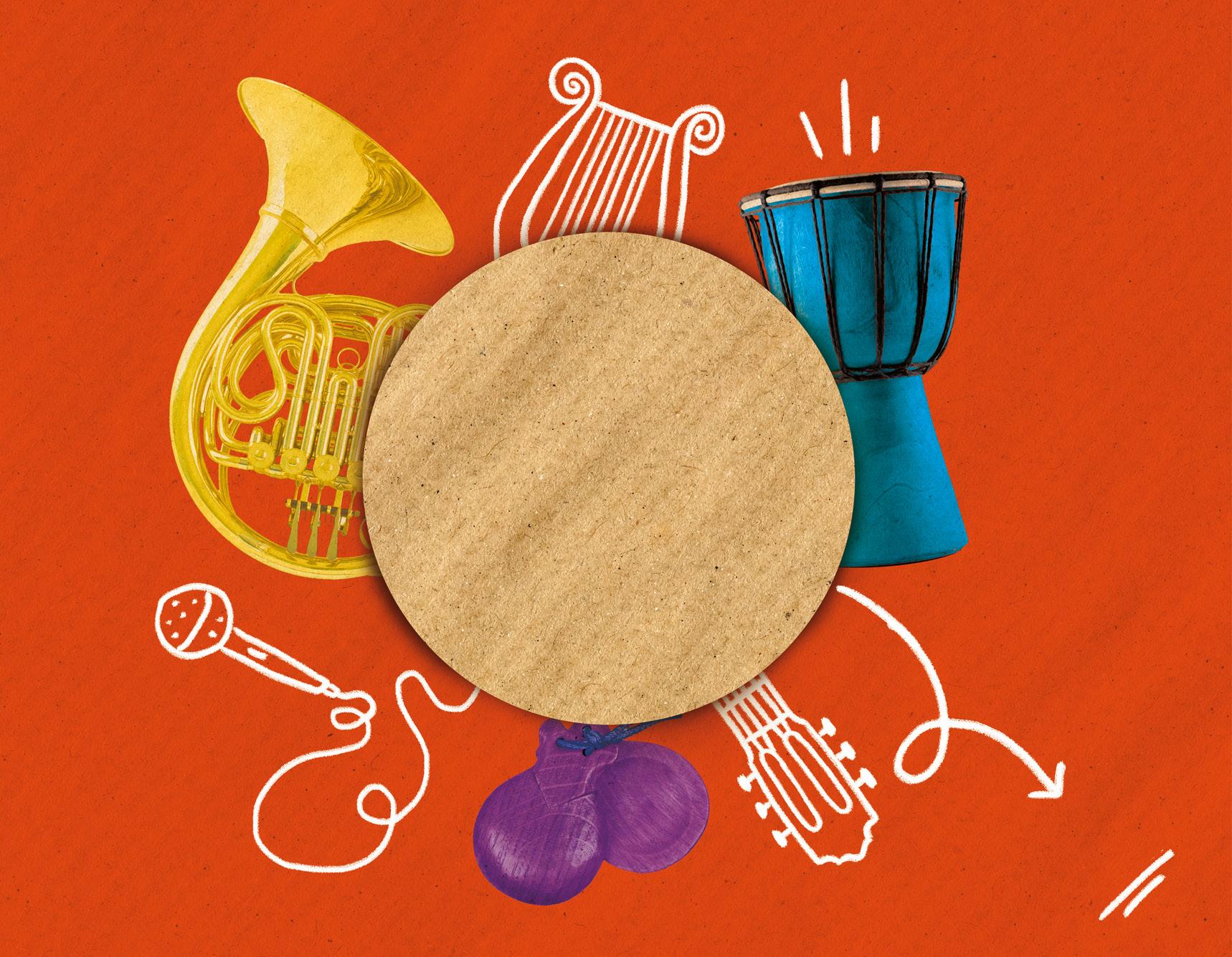
sample
MUSIC Globalaction DIGITAL PROJECT INCLUDED
PERCEPTION AND ANALYSIS
1 Music without borders
Create a playlist with your favourite music and find a way to get it to children who haven’t got internet access.
2 Listen to the water’s song!
Think about how we can raise awareness in our school about the responsible use and consumption of water. Make up the lyrics to a song about it that you can perform at a school festival.
• Sound and silence. Auditory discrimination of the qualities of sound.
• Nuances of intensity: “Farruca”, El sombrero de tres picos, Falla.
• Identification of dance styles and follow-up of form in a stick dance.
• The bouzouki in traditional Greek dances.
• Difference between a bar or measure, rhythm and beat.
• Perception of the stressed syllable of words. The accent.
• Time signature: Duple, triple, quadruple in musical fragments.

• Reading and writing of rhythms schemes.
• The oldest written melodies: the Hymn to Nikkal and the Seikilos Epitaph.
• Andalusian rhythm. The Andalusian copla; festivals and fairs.
• Auditory recognition of simple notes.
• Wind percussion instruments.
• Intervals: definition and identification of different types.

• Power chords as accompaniment with bar percussion instruments; types.

• Roles of staging professionals in the theatre.
• Scenic spaces throughout history.
• A musician and poet: Ziryab.
• Instruments of Spanish folklore with oriental roots.
• Professions in a orchestra.
• Basic guidelines for the corporal expression of rhythmic movement and dance.
• Andalusian rhythm. The Andalusian copla; festivals and fairs.
3 Music to understand us!
Class discussion on gender equality in current music. Researching and creating a small collage with images of some Spanish and Latin American female singer-songwriters.
Reducing inequality
• Symbols of prolongation: tie and dot.
• Intonation of sentences that express the speaker’s attitude.
• Musical fragments for the identification of bars.
• Drawing melodic lines that match the speaker’s attitude.
• Application of the bar line in the rhythms of different bars.
• Auditory identification of two string instruments: the vihuela and the guitar.
• Singing, dancing and guitar playing artists that make up the flamenco scene.
• Identification of the rhythmic and melodic motif.
• Andalusian rhythm. Renaissance and Baroque instruments; Andalucía in Spanish composers.
What are we going to learn?
PAGE PAGE
PAGE
Industry, innovation and infrastructure
Clean water and sanitation
8 32 56
LEARNING SITUATION TARGET IN ACTION SDG
CREATION AND PERFORMANCE
• Songs: The cave, Tafta hindi, Playing instruments.
• Prosodies to accompany with body percussion.
• Vocal interpretation and creation of musicograms using unconventional symbols.
• Accompanying the notes MI, SOL, LA.
• Interpretation using percussion bar instruments: The cave, Tafta hindi.
• Percussion accompaniment: Playing instruments.
• Practicing accent or stress.
• Dance interpretation: The Little Bird (stick dance); Syrtaki Parapoñota (Greece).
• Building an instrument to accompany a carol.
• Songs: I invite you to play, I freeze like a statue.
• Improvisation and creation of rhythmic movements: the Roman Saturnalia.
• The body as an instrument of expression: the Roman Saturnalia.
• Active listening: Persian March, J. Strauss jr. percussion accompaniment. Tremolo practice.
• Creation of small choreographies to accompany Andalusian music.
• The body as an instrument of expression: dramatization of In a Persian market.
• Andalusian rhythm. Voice and body percussion, El Tripili.
• Songs: The mistery of history; Tengo los ojos azules (zorongo); Arirang (traditional Korean).
• Collective interpretation of a dance: Tzadik Katamar (Israel).
• El Conde Flores romance.
• El llivre Vermell. The canon.
• Interpretation with voice, recorder and bar percussion instruments: Arirang.
• The body as an instrument of expression: rumba.
• Collective interpretation of a dance: Spanish Rumba.
• Performance with percusssion bar instruments: Tengo los ojos azules.
• Danza de las hachas, Joaquín Rodrigo.
PLAY THE PART!
Secret rhythms
• Creation, in groups, of a secret code and graphic document with symbols and musical notes.
• Creation of a quadruple metre rhythm using a secret code agreed upon by the group.
• Swapping rhythms with the other groups to be deciphered and interpreted using small percussion instruments.
The notes SI LA, SOL, MI, RE
• Presentation of the note RE.
• Snow in my window.
• Alphabet soup.
The notes DO’, SI, LA, SOL, MI, RE
• Presentation of the note DO’.
• Pirate’s dance.
• Bang’s tower.
The notes RE’, DO’, SI, LA, SOL, MI, RE
• Presentation of the note RE’.
• Day and night.
Preaching from the rooftops
• Group research on ‘pregones’ or street crying songs, their characteristics, the functions of the street crier in the Community.
• Creation of an advertisement related to the school in the form of a public address by a street crier.
• Pooling of the street cries with the rest of the class.
The notes RE’, DO’, SI, LA, SOL, FA, MI, RE
• Presentation of the note FA.
• Night-time brushstrokes.
• The bus blues.
The notes RE’, DO’, SI, LA, SOL, FA, MI, RE, DO
• Presentation of the note DO.
• The thinker.
• Santa María, Strela do día.
Composing a piece
• Creation of a duple-metre rhythm using the notes proposed.
• Invention of a melody from the rhythm created with the sounds of the pentatonic scale.
• Creation of a melody in groups based on individual proposals.
• Choosing instruments for the group.
The notes RE’, DO’, SI flat, LA, SOL, FA, MI, RE, DO
• Presentation of the note SI flat.
• Flat SI.
Positions of the notes on the recorder
Andalusian rhythm
• Copla workshop
• Tangos
PAGE 80
Rehearsals
1 Music without borders
Since the beginning of time, human beings have built and developed new objects to make their work easier and to improve their quality of life. Ancient civilisations, such as the Phoenicians, the Iberians and the Greeks, left us technological advances that today are a testimony of their culture.
What do you think?
Is it easy to access the music you like without internet? And when you want to discover music from other countries such as Japan, India or Argentina?
Context
A significant part of the world’s population hasn’t got an internet connection.
Target in action
Create a playlist of your favourite music and find a way to get it to children who haven’t got internet access.

8


9
PERFORMANCE
The Cave
1 Listen, sing and accompany.



We’re entering the cave now, we’re going to look around. I see some good materials. Why are they lying all about? (repeat)

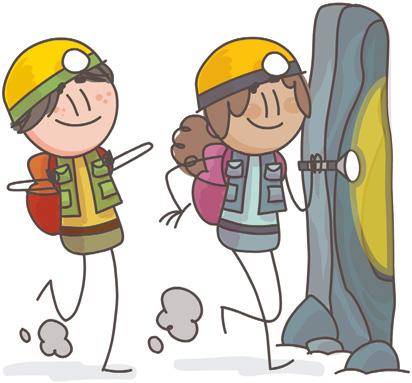
We find rocks and little pebbles, bits of wood among the mud. Then I see a shadow coming! I think I just had enough!
Chorus
Marble statues all around me, hammer, chisel and a brush. Oh, the sculptor is a vampire I am leaving in a rush!
Chorus
High and low
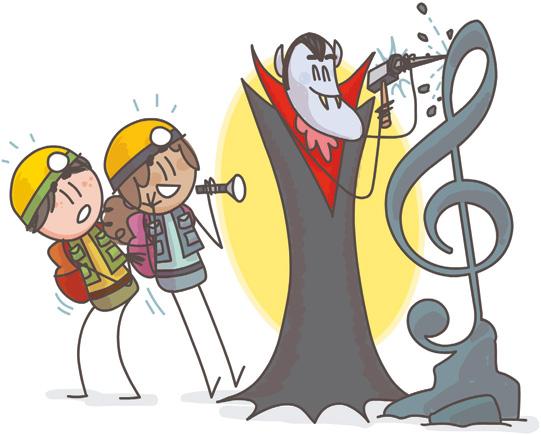
10
Chorus
Soprano
1
MUSICAL LANGUAGE

The qualities of sound
Music is the art of combining sound and silence in a creative way. All sounds have got different qualities.
Questions bag Observe, read and learn how sound is produced. Talk about it in class.

Nature is full of sounds.
Therefore, absolute silence doesn’t exist.
Any sound that we hear has four qualities: duration, timbre, pitch, and intensity.

Silence is the absence of sound.
Everything around us vibrates when moving or when coming into contact with other bodies.
Sound travels in waves through air, water, and some other mediums.
Our ear detects these waves, identifies their qualities and creates an auditory sensation in the brain.
11 U1
The qualities of sound
1 Read and write in your notebook the number each letter corresponds to.




... if a sound is high or low?
...if a sound is long or short?
...if a sound is loud or soft?
... what source does the sound come from?
Which quality of sound tells us...
2 Listen and number in the order that you hear them. In your notebook, write at least two qualities that you perceive in the sound of each of the instruments.





12
MUSICAL LANGUAGE
1
2
3
4 Duration a Timbre b Pitch c Intensity d a c d b
Intensity
The intensity of a sound can be soft or loud. Composers use intensity contrasts to enhance the expressiveness of text and music. The conductor uses gestures to indicate intensity so that the musicians can interpret the melody. Between the two types of intensity, soft-loud, there are different nuances.



Nuances of intensity
Pianissimo () very soft sound


Piano () soft sound
Mezzo forte () medium sound

Forte ( ) loud sound
Fortissimo ( ) very loud sound
1 Observe and complete with nuances of intensity. Listen and move your arms as if you were the conductor of the orchestra.


Manuel de Falla (1876-1946)

‘Farruca’ El sombrero de tres picos
This Andalusian composer, born in Cádiz, is one of the most important musicians of Spanish music.
MUSICAL LANGUAGE
Very soft sound ( )
)
)
Loud sound (
Soft sound ( ) Very loud sound (
Medium loud sound (
13 U1
Body percussion





The beat is the pulse of the music. It generates the rhythm. Rhythm is the result of combining musical notes and is closely related to beat. Look at the stems to interpret clapping.





1 Rehearse them with the help of the prosodies. Write the missing rhythm in your notebook.


Look I fo - llow rhythm well!
I am ben - ding my knees.
It re - so - nates through all the cave.
You must ne - ver lose the beat.
14
PERFORMANCE
4 q q q q q q q q q q q q q q • • • • • • • • Rhythm Bar (or measure) Pulse q q { { { { q q 4 4 4 4 { { q q q 4 4
{ { 4 4
q d q i q q d + i
1
The stick dance
1 Observe and learn the basic movements to the stick dance.


In pairs
Hit the sticks together. Hit inwards, diagonally. Hit outwards, diagonally. Hit in a cross ( ✘ ), with the right and left hand at the same time.




2 Listen to The Little Bird. Accompany with sticks when you hear the dulzaina.

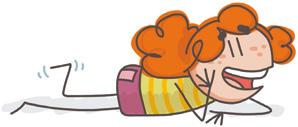

1 st time: rows facing each other
2 nd time: partner next to you
time: rows facing each other
To dance these traditional dances, you can use two cardboard tubes or small plastic bottles as sticks.
15 U1
MUSIC AND MOVEMENT
q q q q q q q q q q 2 4 ✘ ✘ ✘ ✘ ✘ ✘
FORM P1 I P2 I Voice P1 P2 P1 q q q q q 2 4 Individual Introduction Stick dance 1 q 2 4 ✘ ✘ ✘ ✘ ✘
st
q q q q q q q q q q q q q q q q q q q q q q q q q q q q Stick dance 2
Individual
Dance styles
Dance is as old as humanity. Human beings have used body movement as a form of expression and communication since prehistory. Dance is linked to music: a certain style of dance is usually associated with a musical genre.


In ancient cultures, such as the Iberian culture, any important celebration was accompanied with


1 Listen and match each dance style to the music. Number in your notebook in the order you hear them.

Classical music

16
LISTEN
Dance scene. San Miguel de Liria ceramic vessel (Valencia). Iberian ceramics (2nd century BCE).
Rock and roll
Traditional music a b c
Greek dance
1 Listen, learn and dance the Greek dance Syrtaki Parapoñota.
Starting position
Form an open circle, holding hands, with your forearms raised.





Without moving from the spot and with your feet together, raise and lower your heels.
The bouzouki is the most representative instrument of modern Greek music. It is usually used to accompany traditional dances.

Take four steps to the right, bringing your feet together on the fourth step.
Take four steps to the centre. Move the left foot up and back on the fourth step.
Take four steps backwards, starting with the left foot, and bring both feet together on the fourth step.

17 U1
MUSIC AND MOVEMENT
d. i. ( ) d. q i. q i. q d. q d. q i. q ( ) q d. ( ) q 4 4 d. i. i.
( Ò 8) 4 4
Introduction Movements
Form groups of four and decide which symbols you will use in your secret musical code. For example:




Create a four-bar rhythm, with the secret code you have invented. Draw four rectangles in your notebook and draw a bar in each of them.
Draw the symbols you have chosen for each of the musical notes and create the secret code.

18
¡¡
PLAY THE PART!
Secret rhythms Write around STEP 1 STEP 2
= q q q q =
q = q q =
? ? ? ?
STEP 3

Copy the rhythm in your notebook. Swap the rhythm and the code with another group to decipher it. Decipher the secret code of the other group and write the rhythm with the musical notes. Play it with a hand percussion instrument.
Reflect on your experience of creating a secret musical code.
• Was it easy to create a musical code in a group?
• Why?
• Talk to your classmates and write in your notebook how to improve group work.

a Creating my own code
b Speaking in turns

c Taking group suggestions into account
d Avoiding participating
U1
19
1 Listen and sing. Move in a line clapping the beats.


Tafta hindi, tafta hindi shash hariit ia banat.
If ta juuli ia sabaaia
uala jushmi nishibeg. (repeat)
Indian silk and Indian cotton buy in this flea market now! They are silver, they are golden, you can try them on right now. (repeat)

2 Listen and accompany with the bar instruments.
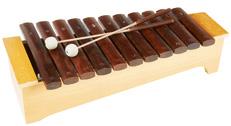


they are you can try them
gol - den now. on right
™ ™ ™ ™ ™ ™ ™ ™ ra das, - plate adas, - son de se da _y - ta fe - tán. - (Son do) - Te lasB & D.C TOTAL 3 & FIN ˙ ˙ œ œ œ œ ˙ ˙ œ œ œ œ œœ œœ œœ œœ ˙ ˙ ˙ ˙ ˙ ˙ œ œ œ œ ˙ ˙ ˙ ˙ ˙ ˙ ˙ Ó ˙ Ó 20 SONG
Tafta hindi
q q q q q 4 4 q q B
sil -
END Soprano High and low Back to A - In - dian Te lasin dias - te las - in dias - va mos - to dos - a com prar. - Son doA 4 4 4 4 & & ŒŒ ˙ ˙ œ œ œ œ ˙ ˙ œ œ œ œ ˙ ˙ œ œ œ œ ˙ ˙ œ œ œ œ ŒŒ ˙ ˙ ˙ ˙ ˙ ˙ ˙ Ó A In - dian In - dian silk and co - tton buy in this flea mar - ket now! They are FORM A B B ( Ò 3)
ver
Notes and rests
The duration of a sound is represented in writing using notes and rests. Each note has got an equivalent silence of the same duration. The crotchet, which is taken as a reference, lasts for one beat.
1 Look at the musical coins and their values. In your notebook, write the equivalence of each chest.
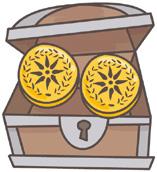





Semibreve (4 beats)
Minim (2 beats)
Remember the duration of the notes and their rests.
Equivalent to

Crotchet (1 beat)
Quaver (1/2 beats)
Semiquaver (1/4 beats)
2 Read and write the answers.
• A semibreve lasts ? beats. It has got the same duration as ? minims, ? crotchets, ? quavers and ? semiquavers.

• The ? .... has got the same duration as eight semiquavers.


21 U1 MUSICAL
LANGUAGE
=
to
= q = = =
Equivalent to
Equivalent
Equivalent to
Name Note Rest q
MUSICAL LANGUAGE
Stress or accent
When we pronounce a word, we always give special emphasis to one of the syllables. It is called tonic accent or prosodic accent. The syllables that are emphasised are stressed. Those that aren’t emphasised are unstressed. That ‘natural’ rhythm of the words facilitates the musical rhythm.
1 Observe and interpret the prosodic rhythm with claps.
One syllable fish
Two syllables (bass) mu sic
Two syllables (high pitched) device
Three syllables cla ssical

2 Copy the following couplet in your notebook. Recite it and paint an orange star on the accent of each word that has got more than one syllable.

Three syllables (bass) fan tastic
Before the existence of the guitar, Phoenicians, Tartessians, Celts and Iberians played lyres and harps.
Three syllables (high pitched) under stand

22
✷
✷ ✷
✷✷✷
✷ ✷ ✷
✷✷✷
✷ ✷
This guitar that I’m playing knows how to speak, but its eyes are missing and it can’t peek.
MUSICAL LANGUAGE
Time signatures
1 Read and remember the time signatures. Practice them with a tennis ball.



The beats are grouped together to form a bar.
The first beat of each bar is the one with the accent.
The sign indicates which beat has got an accent in the score.
2 Copy the rhythms in your notebook. Read and complete freely. Listen and interpret the rhythms following the beat of the music.

3 Copy the stave in your notebook. Create and write a melody using the notes MI, SOL, LA. Interpret.
3 4
23 U1
2 q q q q q q q q q q q q q q 1 2 1 2 3 1 2 3 4 Duple
Triple
Quadruple
&
IMAGINATION 3 q q q q q q q q q q q q q q q q 4 q q q q q q q q q q
USE YOUR
Playing instruments

1 Listen, learn and sing the Christmas carol. Accompany with percussion.


Oh come, oh come little shepherds, the baby is waiting for you tonight. Bring fiddle and horn to the stable, sing joyfully to the little child.
Play and dance with the castanets. Play your fiddle and blow your horn. Sing together the Christmas carols. A special baby is born.
The ox and the donkey are nice and warm, in their bed of straw and hay. They keep the family company, in Bethlehem on this special day.
Chorus
The happy shepherds bring lambs and sheep!
The dog and the cattle, they come too. Every creature in harmony, Up in the sky, there’s a star in view.
Chorus (repeat)
2 Listen and choose three instruments from the Christmas carol. Write their names and draw them in your notebook.

In Phenicia, we also played the tambourine.


24 SONG
q q 4 3 q q q q 4 3
Accompaniment with percussion

1 Listen and accompany the Christmas carol as indicated.

Big Bel- ly John Bong. Big Bel- ly John Bong
Pan, pan, play Pe- ter Pan.
Toon, Toon, car- car- toon.
2 Look and make an instrument from walnuts.

toon.
Coloured markers

Walnut shells
Wooden board

Stick the walnut shells to the board as shown in the image. Then decorate the instrument to your liking.





Hold the instrument with one hand, and with the other hand scratch the walnuts with the wooden stick.

25 U1
PERFORMANCE
Prepare Make Rehearse q q q q q q 3 Q q q q q { {
q q q q q q 3
{ {
q q q q q q 3 Q { {
Q
1 Read and answer the questions in your notebook.
The Tambourine, your digital music magazine
What is the oldest melody in the world?
Music archaeology has deciphered two important finds that turned out to be the oldest musical pieces in history.
The Hymn to Nikkal, goddess of the Phoenicians, is considered to be the oldest musical work, although it isn’t complete. It was written around 1400 BCE. It is made of clay tablets. A prayer and some symbols, which represent sounds, are engraved on them. It has got instructions on how to play the melody on the harp or lyre.

The Seikilos Epitaph is the first complete musical work known. An epitaph is a short text written to remember the deceased. This epitaph was placed by order of Seikilos on his wife Euterpe’s tomb in around the 2nd century BCE. It appears on a marble column with a Greek text engraved. There are letters and signs that indicate the pitch and duration of the sounds.
The Hymn to Nikkal is very valuable. It is the first time that music was written.
The Seikilos epitaph is the first known sheet music with signs marking pitch and sound duration.


• The most recent composition is ? ....
• On what material was the Hymn to Nikkal made? ?


• An epitaph is ?
• Explain similarities between both pieces. ?
26
MUSICAL
CULTURE Music in ancient times
Voice musicogram



1 RQAS Look at the musicogram and interpret it with your voice.
USE YOUR IMAGINATION
2 Explore new symbols and create your own musicogram in your notebook. Perform it in front of the group.

27 U1
INTONATION
The Andalusian copla
The Andalusian copla, also known in Spanish for canción española, is one of the richest forms of expression for Andalusian people. It is a popular Spanish genre, frequently sung by Andalusian tonadilleras women.
The themes of these songs retain features of flamenco and usually revolve around the theme of love.
The copla is an artistic genre in which the music, the lyrics and the way each artist interprets it are of great importance


Pastora Imperio was one of the first copla singers. She was a muchadmired woman and the muse of some artists of the time, such as the painter Julio Romero de Torres.
Rocío Jurado alternated the copla with romantic ballads, giving her international fame. She was also talented at flamenco singing.


1 Look for information and write a list of copla singers in your notebook.

2 Do you remember the name of any coplas? Write them in your notebook and listen to some of them online.
Carlos Cano, singer-songwriter from Granada, known by many as ‘the voice of Andalusian people’. He recovered relatively forgotten traditional Andalusian styles such as the copla.

ANDALUSIAN RHYTHM
28
Festivals and fairs
In Andalucía, festivals and fairs are very varied popular celebrations exhibiting the different folkloric traditions of our land.

The origin of many of the festivals is religious: Semana Santa (Easter) in Andalucía; Corpus, in Granada; Las Cruces de Mayo in Córdoba, Almería and Granada; El Rocío of Almonte, etc.


No festival takes place without the presence of music, be it singing, dancing or playing instruments.

But we also celebrate non-religious festivals in our community: Carnival in Cádiz and, in other cities, the Vendimia in Jerez or the Moros y Cristianos festival of Granada.
Fairs ( ferias) arose several centuries ago with the purpose of buying or selling agricultural products, crafts and livestock. Currently their character is purely festive. The Feria de Abril de Sevilla, the Feria de Malaga, or the Feria del Caballo in Jerez de la Frontera are renowned for their attractiveness and international fame.
29
U1
What have I learned?
1 Read and complete in your notebook.
• Sound travels in waves through ? , ? , and some other mediums.


• Any ? we listen to has got four qualities: ? , ? , ? , and ?
• The beat generates the ? .... .
2 Look and write the corresponding bar in your notebook. Play with percussion.
Copy and colour in your notebook: if you know the answer if you needed help if you haven’t been able to answer it
3 Read and write in your notebook each star code the word it corresponds to according to its accent.
PORFOLIO
30
PORTFOLIO
Review the essential concepts of the unit at anayaeducacion.es .
q q q q q q q q q q q q q q q q q q q q q q q q q q q q q q q q q q q q q q 1 2 3
guitar 1 conductor 2 musical 3 a ✷ ✷ b ✷ ✷ ✷ c ✷ ✷ ✷
How have I learned? TARGET IN ACTION
1 Copy in your notebook this protractor and asign the 180° between these three musical abilities, depending on how well you have done in each one of them.

Timeline Arrange your favourite songs in a playlist. On a timeline, indicate the order of steps you would follow to send them to a group of boys and girls who haven’t got internet access. You can use the following graphic organiser.
Where do they live?
How can I justify my project?
Interpretating songs
Interpretating using a bar instruments
Movement and dance
What NGOs work in the area and how can I contact them?


In what format can I send the songs and how?

90 100 80 70 60 50 40 30 20 10 0 110 120 130 140 150 170 160 180 31 U1
? ? ? ?
© GRUPO ANAYA, S.A., 2023 - C/ Valentín Beato, 21 - 28037 Madrid.
All rights reserved. No part of this publication may be reproduced, stored in a retrieval system, or transmitted, in any form or by any means, electronic, mechanical, photocopying, recording, or otherwise, without the prior permission of the publishers.











































































































